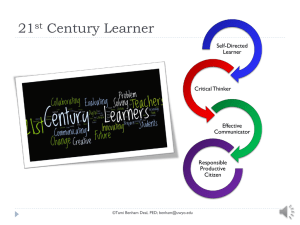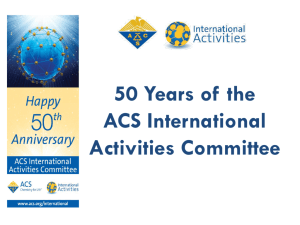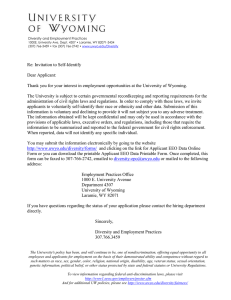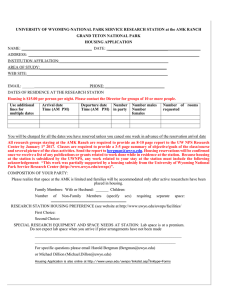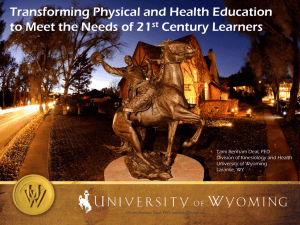2013 Central District Presentation Part 3
advertisement
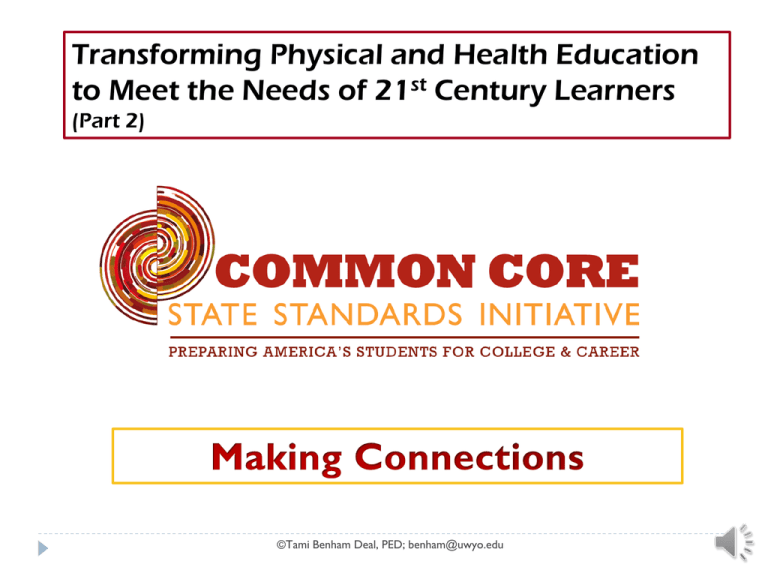
Transforming Physical and Health Education to Meet the Needs of 21st Century Learners (Part 2) ©Tami Benham Deal, PED; benham@uwyo.edu English Language Arts Grade Level Standards in ELA Reading Writing Speaking and Listening Language ©Tami Benham Deal, PED; benham@uwyo.edu K-8, grade-by-grade 9-10 and 11-12 bands Reading Key Ideas and Details Craft and Structure Integration of Knowledge and Ideas Range of Reading and Level of Text Complexity Foundational Skills (K-5) Literature (K-5, 6-12) Literacy in History/Social Studies Informational Text (K-5, 6-12) Literacy in Science/ Technical Subjects ©Tami Benham Deal, PED; benham@uwyo.edu Reading: Informational Text Grade 2 Health Education Determine the meaning of words and phrases in a text relevant to a grade 2 topic or subject area. Use, Misuse, Abuse ©Tami Benham Deal, PED; benham@uwyo.edu Reading: Informational Text Grade 4 Health Education Determine the meaning of general academic and domain-specific words or phrases in a text relevant to a grade 4 topic or subject area. Medicine, Alcohol ©Tami Benham Deal, PED; benham@uwyo.edu Reading: Informational Text Grade 6 Determine the meaning of words and phrases as they are used in a text, including figurative, connotative, and technical meanings. Health Education “Use only as prescribed” “Recommended dose” http://kidshealth.org/teen/drug_alcohol/dr ugs/know_about_drugs.html# ©Tami Benham Deal, PED; benham@uwyo.edu Reading: Informational Text Grade 8 Determine the meaning of words and phrases as they are used in a text, including figurative, connotative, and technical meanings; analyze the impact of specific word choices on meaning and tone, including analogies or allusions to other texts. Health Education ©Tami Benham Deal, PED; benham@uwyo.edu Reading: Informational Text Grades 9-10 Health Education Determine the meaning of words and phrases as they are used in a text, including figurative, connotative, and technical meanings; analyze the cumulative impact of specific word choices on meaning and tone (e.g., how the language of a court opinion differs from that of a newspaper). ©Tami Benham Deal, PED; benham@uwyo.edu Reading Standards for Literacy in Science and Technical Subjects Making Connections To transform health and physical education How could you implement these standards in your physical education classroom? Grades 9-10 Translate quantitative or technical information expressed in words in a text into visual form (e.g., a table or chart) and translate information expressed visually or mathematically (e.g., in an equation) into words. Translate health benefits of exercise from a heart rate graph depicting percentage of time workout falls above, below, and within target Assess the extent to which the reasoning and evidence in a text support the author’s claim or a recommendation for solving a scientific or technical problem. Read an article on using steroids to enhance athletic performance to assess reasoning and evidence, like: Max Roosevelt. (2010, January 14). When the Gym Isn't Enough:[Style Desk]. New York Times) Compare and contrast findings presented in a text to those from other sources (including their own experiments), noting when the findings support or contradict previous explanations or accounts. Investigate if students accommodate for non-PE days by being more physically active after school on non-PE days than on PE days. Compare research to findings student collects with school pedometers. ©Tami Benham Deal, PED; benham@uwyo.edu Writing Text type and purposes Production and distribution of writing Research to build and present knowledge Range of writing Writing Standards (K-5, 6-12) Writing Standards for Literacy in History/Social Studies Writing Standards for Literacy in Science/ Technical Subjects ©Tami Benham Deal, PED; benham@uwyo.edu Writing Standards for Literacy History/Social Studies, Science, and Technical Subjects • Gather relevant information from authoritative print and digital sources, using advanced searches effectively Text Types and Purposes Production and Distribution of Writing Research to Build and Present Knowledge Range of Writing • Assess strengths and limitations of each source in terms of the task, purpose, and audience • Integrate information into the text selectively to maintain the flow of ideas, avoiding plagiarism and overreliance on any one source and following a standard format for citation ©Tami Benham Deal, PED; benham@uwyo.edu Making Connections To transform health and physical education • Gather relevant information from authoritative print and digital sources, using advanced searches effectively • Assess strengths and limitations of each source in terms of the task, purpose, and audience (and validity) WY Health Education Standard #1 HE.12.1.1 Locate and evaluate appropriate resources at school, in the community and beyond that help to enhance health (e.g., human resources, printed and electronic resources, equipment and facilities). HE.12.1.2 Locate and evaluate appropriate resources at school, in the community and beyond that help to reduce health risks (e.g., human resources, printed and electronic resources, equipment and facilities). HE.12.1.3 Use criteria to evaluate the validity of health information from a variety of sources (e.g., written, verbal, visual, electronic, etc.) ©Tami Benham Deal, PED; benham@uwyo.edu Making Connections To transform health and physical education W 9-10 Text Type and Purposes Write arguments focused on discipline-specific content a. b. Introduce precise claim(s), distinguish the claim(s) from alternate or opposing claims, and create an organization that establishes clear relationships among the claim(s), counterclaims, reasons, and evidence. Develop claim(s) & counterclaims fairly, supplying data and evidence for each while pointing out the strengths and limitations of both claim(s) & counterclaims in a disciplineappropriate form… WY HE 2 – PROBLEM SOLVING AND DECISION MAKING HE12.2.5: Apply a systematic process to evaluate the evidence, claims, beliefs and/or points of view about non-familiar health related issues or problems. ATOD, NUT, PA ©Tami Benham Deal, PED; benham@uwyo.edu Making Connections To transform health and physical education FTC Alleges Claims Are Not Backed by Adequate Scientific Evidence In a settlement reached with the Federal Trade Commission, mouthguard marketer Brain-Pad, Inc. and its President Joseph Manzo are barred from making unsupported claims that their mouthguards reduce the risk of concussions from lower jaw impacts, reduce the risk of concussions generally, or have been clinically proven to do either. As part of the FTC’s ongoing efforts to protect consumers from over-hyped health claims, the settlement also prohibits Brain-Pad and Manzo from misrepresenting the health benefits of any mouthguard or other athletic equipment designed to protect the brain from injury. http://www.ftc.gov/opa/2012/08/brainpad.shtm http://www.brainpads.com/ PE 11.2.3: Students will be knowledgeable consumers of fitness products and services. HE12.2.5: Apply a systematic process to evaluate the evidence, claims, beliefs and/or ©Tami Benham Deal, issues PED; benham@uwyo.edu points of view about non-familiar health related or problems. ATOD, NUT, PA Writing Standards for Literacy 6. Production and Distribution of Writing (gr 6) Use technology, including the Internet, to produce and publish writing and present the relationships between information and ideas clearly and efficiently. 6. Production and Distribution of Writing (gr 3) • With guidance and support from adults, use technology to produce and publish writing (using keyboard skills) as well as interact and collaborate with others. PE8.3. Students demonstrate 2 sportsmanship, cooperation, and teamwork in physical activity settings. http://www.yourcomicstrip.com/ PE4.2.2 Students demonstrate an understanding of the health benefits of being physically active. • http://launchpadtoys.com/toontastic/#in-action ©Tami Benham Deal, PED; benham@uwyo.edu Making Connections To transform health and physical education PE11.1.3 Students demonstrate an understanding of rules and strategies in: a. rhythms or dance, b. regulation or form team activities, c. regulation or form individual or dual activities, and d. lifetime activities. itunes - Idea Sketch https://itunes.apple.com/us/app/ideasketch/id367246522?mt=8 6. Production and Distribution of Writing (gr 11-12) • Use technology, including the Internet, to produce and publish, and update individual or shared writing products in response to feedback, including new arguments or information. ©Tami Benham Deal, PED; benham@uwyo.edu
